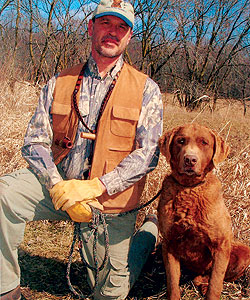By James B. Spencer
 Robert Budnik |
"The ideal conditions for introducing a pup to water," Bob said, "would include an air temperature of about 85 degrees, water temperature of about 65 degrees in a crystal-clear creek or pond with a sandy, gradually sloping, and shallow bottom. Before getting him wet, you should give your pup a fairly long romp on land to work up some heat, so the cool water will seem pleasantly refreshing to him and just might begin a lifelong love of water."
Bob said that if conditions are just right, as a new owner you should introduce your pup to water quite early, perhaps when he's eight to 12 weeks old, as long as he's well-socialized, bonded with you, and comfortable with his new surroundings. As a breeder, Bob often has a litter swimming in a pack with their dam at four weeks.
"I always go in with the pups," he said, "wearing only sneakers, or even barefooted, but never waders. Like us, pups are flesh and bone, so I want to know what the water feels like before encouraging them to follow me in. If it's not right, I keep them out."
Bob stressed that you should always start by leading a puppy into water, and never by forcing him. However, if a pup refuses to follow him in every day for a couple of weeks, Bob picks the pup up, carries him out 10 to 20 feet from shore in water that's only belly-deep for the pup, and gently lowers him into it. Then Bob wades back to shore, with the pup following him.
"I do that maybe 50 times in a long and leisurely walk along Lake Michigan's shore," he said. "The puppy loses his fear of water rather quickly this way, and I'm not forcing him."
Thereafter Bob takes the pup on frequent and long shoreline walks. Sometimes running, sometimes walking, Bob moves through shallow water, first where the pup can wade, later where he must swim. He praises all successes and stops occasionally to pet the puppy. This helps develop the youngster's love of water and swimming.
When the pup is retrieving eagerly on land and is swimming comfortably during these shoreline romps, Bob tosses a clip-wing pigeon a short distance (five to 20 feet) out into the water and lets the pup chase it, catch it, and retrieve it. Lively clip-wings excite and motivate the pup, thereby convincing him that only good things happen in water.
"All early retrieves are with clip-wings," he said. "First pigeons and then later, when the pup can handle them, ducks." Bob gradually lengthens the retrieves, with the emphasis on "gradually," so as to avoid refusals. Every refusal is a red flag that forces you to go back and repeat a few steps.
| Introducing Your Puppy | 

Don't miss tips for your pointer here, or your spaniel here.
|
|
Bob said that the most common mistakes beginners make are expecting the pup to enter the water alone, without motivation; tossing a dummy out too far, especially in swimming water; lengthening the retrieves too rapidly; expecting the puppy to swim in water that's too cold or in a stream that's too swift; and being too demanding, thereby turning what should be fun for the puppy into a nightmare.
Bob concluded with this warning about putting your trained retriever at risk later on while hunting: "Some very intense retrievers won't give up on a lively cripple that hits ice-cold water 100 yards out and then struggles to get away on a wind-blown lake, always staying a few yards ahead of the dog.
"When you sense such a situation is impending, don't send your dog! Instead, just keep him sitting safely at your side. Why risk your well-trained retriever's life on a retrieve that is a long shot at best? Even the toughest Chesapeakes are flesh and bone and can drown from hypothermia."
This tip is from Robert Budnik of Lakeshore Kennels, 7806 County Road R, Manitowoc, WI 54220; (920) 682-2473; www.lakeshorekennels.com; h2odogs@lakeshorekennels.com. Bob has been training all sporting breeds professionally for 32 years, specializing in hunting dogs. He has trained and handled retrievers in hunting tests, and has judged retriever hunting tests. He breeds Chesapeake Bay retrievers.






